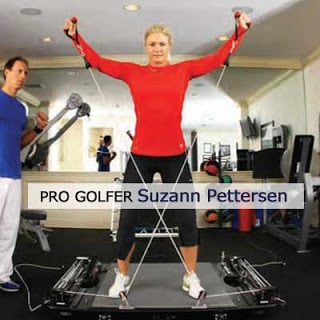VetiMax golf training is perfect for improving golf performance as it provides a loaded resistance on natural movements and allows a full range of motion. This allows for improvements in explosive power, strength, mobility, and just about any other variable for performance.
Where VertiMax really stands out is it allows sport-specific movements in ways no other piece of training equipment can.
Golf originated in the 15th century in Scotland. The sport of golf evolved into the "gentleman's game". However, even though it may not be regarded as a strength sport, you would be foolish to think you don't need to proper strength and conditioning to excel at this this game.
Golf is just like any other sport. When you improve variables such as strength and power, it will have a direct influence on your golf performance.
Why VertiMax Golf Training Improves Strength & Conditioning
While often overlooked in the past, a recent trend in the sport of golf has seen the appreciation and need for a proper strength and conditioning program to optimize a golfer's performance. The golf swing is a full-body motion that involves every joint in the body as a chain of events to produce optimal power levels. Multiple studies have shown that implementing strength and conditioning with golf training can make significant improvements. Check out these VertiMax Golf Exercises.
The main benefit for golfers is ".development of explosive, anaerobic physical qualities to enhance a player's ability to generate high levels of ground reaction force and angular velocity of the clubhead….and develop adequate levels of flexibility, muscle balance, strength."
How VertiMax Strength and Conditioning Training Improves Golf
1. Increases Power
Improving your power is going to perhaps have the most significant benefit in improving your golf game. This is due to their being a direct correlation to clubhead speed and hitting distance. And how do you improve clubhead speed? By improving power production, mainly through something known as "rate of force development" and "ground reaction forces".
This is because the time spent from initiation of the downswing to contact is .290 seconds in male professional players. That's not a lot of time to produce power. These increases in power come from performing powerful and explosive movements that will improve neural drive, motor recruitment, and overall neuromuscular efficiency.
2. Improves Strength
Think about what would happen if a golfers club was made of styrofoam; it would obviously bend as the golfer swung it. This is the perfect illustration of why, as a golfer, your body needs to be strong, just like the club; so that it can withstand the excessive forces without collapsing!
Golf strength is needed for a variety of reasons. The first is to support and add to power production. The golf swing is multi-faceted and includes multiple moving factors. The body must be strong enough to maintain a rigidness through the entire swing to optimize full power. This is especially seen in the clubhead just prior to hitting the ball and upon impact. The athlete must be able to add torque to the club as well as resist the kickback upon hitting the club.
The other central area for strength is the core. Unlike commonly thought, the core does not produce power. The power comes from the hips and rotation of the body, while the core's job is to again maintain stiffness throughout the swing. This means you need a core built like a beam of steel!
3. Improves Mobility And Flexibility While Reducing Injury
The last main aspect of a strength and conditioning program is to improve mobility and flexibility. This is not only important to reduce injury but also to maximize the power generated from the body. Golfers are required to produce maximal forces in a rotational direction with a large ROM repeatedly. This means their muscles, joints, and tendons must be able to withstand these forces. It's important to note that advanced golfers are found to possess significantly higher degrees of mobility and ROM in multiple joints, including the shoulders, hips, and torso.
While it is unclear if clubhead speed is directly related to flexibility, it will definitely keep you from being injured. Still, there is always the plausibility that more flexibility and mobility could allow a golfer to perform a larger backswing, thus enhancing swing speed.
The good news is that golfers rarely need to implement specific mobility and flexibility exercises, assuming athletes are performing movements with a full range of motion.
That being said, it still wouldn’t hurt to incorporate a basic flexibility routine after a session. This should include movements to work the posterior chain, shoulders, and torso.
Basic Flexibility Routine
-
- Dowel work
- Posterior chain movements such as sit and reach
- Hip swings
- Holded twists
4. Reduces Golf Injuries
The above three performance variables will improve performance and drastically decrease the rate of injury; specifically strength and mobility. However, they’re going to decrease injury rates as well. Golf is still very stressful on the body; especially considering the athlete is repeatedly performing the same movement with maximal force.
Pros and Amateurs Golfers Use VertiMax
VertiMax is quickly gaining traction as a swing power generation tool. PGA tour pros and amateurs alike have recognized VertiMax's capabilities to improve hip rotation speed and power. And the benefits? Longer distance, greater club speed and bigger shots.

"Rotation and power are such a huge part of golf," said Al Marez, VertiMax V.P. of Business and Development. "The VertiMax is designed to increase speed and explosiveness, two of the integral parts of a golf swing. Once golfers try our product, they are hooked." He adds, "Golf requires an excellent combination of strength, speed, power and balance to excel. Implementing VertiMax in your golf strength training program will dramatically increase explosive club head speed and speed endurance to radically elevate any player's game. VertiMax is the best system to quickly develop a dominant your swing by radically improving acceleration, deceleration and drive distance."





.png?width=110&name=Listing%20Image-basketball%20ladder%20drill%20%20(350%20x%20350%20px).png)














